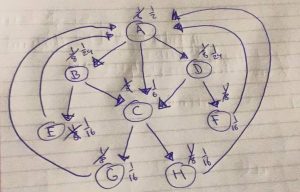Pagerank – A mechanism to combat fake news?
http://www.computerworld.in/feature/can-algorithms-really-tackle-fake-news-fiasco
As of late, the propagation of fake news has grown to become one of the most controversial, talked about phenomena in the world, especially with its supposed role in producing the polarizing outcome of the latest American election. The issue of fake news is not limited to the stage of the politics of the United States, as the article describes an internet hoax that led many residents of Mumbai, India, to believe that their city was about to fall victim to a devastating cyclone. Today, when an individual opens their social media, be it Twitter, Facebook, or Instagram, it is almost even an expectation that he or she would come across some form of falsified news. Regardless of the purpose it may be intended to serve, wether it be click-bait to promote a website, or blatant propaganda to support a political cause, fake news is undoubtably a sensation of concern for many, given its ability to mislead the masses with ease. In consideration of the the vast audience that Fake News can reach through the medium of the internet, it is no surprise that individuals have given thought to strategies that could combat the spread of such fabrication that make use of the web.
The article cites Pagerank as a tool that the internet-service-based mega-company Google would choose to utilize in its battle against Fake News. Pagerank, as discussed in class, is an algorithm and mechanism that can be used to evaluate the importance and relevance of a webpage based upon the number of, quality, and credibility of links to the page in question. It acts in a fluid manner as it passes through a network of webpages, with Pagerank units being passed along links between webpages, with those carrying the greatest final accumulation of the Pagerank units being considered the most important and reliable, and so forth. The mechanism works in a manner as depicted in the theoretical situation depicted in the diagram below.
Suppose in the diagram above, with the network containing 8 sites, that a unit of Pagerank was split evenly amongst the nodes, meaning each would receive 1/8. Each site divides its Pagerank to the other sites to which it bears links. So for instance, A splits its 1/8 amongst B, C, and D, with each of them receiving 1/24. B splits its 1/8 between E and C, giving each 1/16, as does D with F and C. C splits its 1/8 between G and H, giving each 1/16 as well. At this point the values of Pagerank received are as follows – B: 1/24 , C: 1/6 , D: 1/24 , E: 1/16 , F: 1/16 , G: 1/16 , H: 1/16. The only node that still hasn’t received its Pagerank yet is A, which is given 1/8 from each of E, G, H, and F, respectively, leaving it with the highest Pagerank value of 1/2. Such illustrates how the system functions to determine the more reliable sites from the less reliable ones on basis of the quantity (the more links to a page the higher the page rank) and quality (if one continues down the cycle, the pages with the links from higher pagerank sites in turn receive higher pagerank values) of the links.
Evaluating the choice to use Pagerank to help combat fake news as described in the article, one can infer that such would be a good mechanism of choice, given that by using the Pagerank mechanism to rank pages in order of importance and reliability as such, it can be assumed that the pages with Fake news would be referenced far less often than official, more reliable webpages, hence causing the pages containing fake news to appear far less frequently, and far below more credible sources of information.

